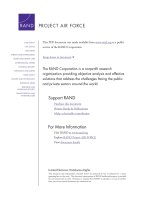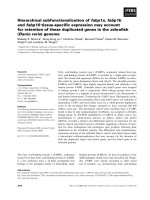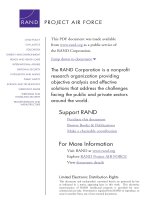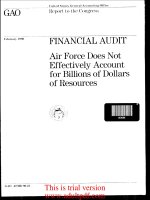FINANCIAL AUDIT Air Force Does Not Effectively Account for Billions of Dollars_part6 pptx
Bạn đang xem bản rút gọn của tài liệu. Xem và tải ngay bản đầy đủ của tài liệu tại đây (1.05 MB, 12 trang )
Inventory Systems Do Not Provide Accurate
Firbncial Data
The systems that are supposed to provide accountability and financial
control over the $63.8 billion invested in inventories of spare parts and
supplies do not provide accurate, reliable data supporting either the
quantities or the value of these inventories. Using inaccurate informa-
tion for purchase decisions can result in unnecessary procurement and
excess inventories in some instances and shortages in others. Building
inventories in excess of requirements wastes tax revenues that are
sorely needed elsewhere. Conversely, inadequate inventories inhibit the
Air Force’s ability to fulfill its mission.
Air Force managers cannot be sure they have accurate information to
use in determining when to procure items unless a physical count of sup-
plies and spare parts is made. Serious inaccuracies in the pricing data
for inventories compound the problem. Even if reliable data can be
obtained, their usefulness is limited if the systems are not constructed to
generate good cost accumulations. Accumulation of cost information in
the accounting records can also provide information on cost trends use-
ful for budgeting as well as information to help control operations.
Accordingly, an inventory system which will satisfy such needs should
be capable of
l
assigning a cost to each stock item in the inventory;
. tracking the movement of inventory;
e maintaining records of input, usage, and quantities on hand;
l
being reconcilable with physical counts;
.
assigning a value to usage (such as average cost) identified by program
or other classifications; and
. making comparisons with requirements.
The Air Force systems do not provide this information; therefore, it is
not available for purchasing new inventory items in the most cost-
effective manner, analyzing cost trends, or controlling material usage
and repair costs.
Scope of Inventory
Management
Operations
*
plies and spare parts, eight times the inventories reported by General
Motors, one of the largest corporations in the United States. These
inventories are maintained at over 130 bases located throughout the
world. Air Force inventory management is an extremely complex task
due to the size of its operations, frequent technological obsolescence of
Page 61
GAO/AFMD-90-23 Air Force Financial Audit
This is trial version
www.adultpdf.com
Chapter 5
Inventory System Do Not Provide Accurate
FimnciEll Data
inventory items, and the need to decentralize storage for national secur-
ity reasons. To maintain and support its operations and weapons sys-
tems, the Air Force manages about 1.6 million different types of spare
parts and supply items. The Air Force Logistics Command
(AFLC)
and
five Air Logistics Centers
(ALCS)
use a number of highly complex finan-
cial and logistics systems and subsystems to compute requirements, fill
orders, track inventory quantities, and value inventory.
ALCS
procure items on the basis of requirements computations, which in
turn are determined by a variety of factors, including quantities of
inventory items on hand, in transit, and in the repair process; projected
usage rates; and procurement lead times. In recent years, we have issued
several reports’ relating to problems found in the requirements determi-
nation process. Among the problem areas reported are inaccurate sys-
tems and procedures for determining inventory requirements and
identification of inventory inaccuracies and their causes.
The items purchased as a result of the requirements determination pro-
cess are received at warehouses, stored, and issued to customers world-
wide. During this process, perpetual inventory systems monitor the
quantities of each item to provide accountability over the items (that is,
where the items are and how many are at each location throughout the
Air Force). Perpetual inventory systems are designed to track invento-
ries on an item-by-item basis, increasing recorded quantities for each
unit received and reducing them for each unit issued. This type of sys-
tem can provide managers with up-to-date, detailed information on
which to base decisions. However, periodic physical inventory counts
are also needed to substantiate the information maintained in the per-
petual system to ensure that all transactions were recorded properly
and to account for any theft or spoilage.
Each inventory item maintained by Air Force has a unique national
stock number
(NSN)
by which it is classified and recorded in the perpet-
ual inventory system. For each
NSN,
hundreds or even thousands of indi-
vidual units may be in stock at (1) one or more of the
ALCs,
where
central inventories are maintained, (2) Base Supply units, where Air
Force operating units have ready access to them, or (3) the Depot Main-
tenance Service, Air Force Industrial Fund operations (depots), where
‘Air Force Budget: Potential for Reducing Requirements and Funding for Aircraft Spares (GAO/
- -
90BR, February 18,1988), DOD Inventory Management: Revised Policies Needed (GAO/
NSIAD-88-76, January 14, 1988), Military Logistics: Buying Spares Too Early Increases Air Force
Costs and Budget Outlays (GAO/mD-86-149, August 1, 1986), and Procurement: Spare Parts Ini-
tiatives Air Force Implementation (GAO/NSIAD-87-28, February 13,1987).
Page 62 GAO/AFMD-90-23 Air Force Financial Audit
This is trial version
www.adultpdf.com
Chapter 5
Inventory Systems Do Not Provide Accurate
Fiuancial Data
they are used to repair and maintain aircraft, engines, missiles, and
related components.
While
ALCS
are responsible for maintaining the bulk of the inventory, the
air bases and the depots also maintain inventories to fulfill their respec-
tive missions. Table 5.1 shows the inventories at these activities.
Table 5 1: Inventory Distribution as of
Septe
1
ber 30,1986
Dollars in billions
Activity/location
Value
-~
ALCs
$40.4
~-
___-
Depots
1.1
Air bases -___
22.3
_
Total
$63.6
Inaccurate Records of
Maintaining accurate records over inventories has been a long-standing
Inventory Quantities
problem for the Air Force. The inventory accountability systems which
the
ALCS
use to track the location and quantities of inventory items do
not provide reliable, accurate inventory data to managers. Inaccurate
inventory records can cause critical supply shortages, prolonged delays
in filling requisitions, or unnecessary procurements resulting in excess
inventory. Although the Air Force has recently improved the accuracy
of its data in automated perpetual inventory systems and generally
takes accurate physical inventory counts, we believe the perpetual
records are still too unreliable to be used in making effective and effi-
cient decisions. A perpetual inventory system should be capable of pro-
viding data to answer the following questions:
. What inventory items were acquired and how much did they cost?
. Where did the inventory items go? (Data should be available both in
terms of quantities and values.)
. How much inventory has been used?
. How much inventory is on hand? (Data should provide quantity, value,
and location of inventory items.)
. How much inventory is needed or not needed? (Data should provide
both quantities and locations.)
Problems with inventory accuracy have been the subject of congres-
sional hearings and
GAO
and Air Force Audit Agency reports for many
years, Some improvements have been made as a result of a number of
programs the Air Force initiated to improve inventory accuracy. Since
Page 63 GAO/AFMD-90-23 Air Force Fiuaucial Audit
This is trial version
www.adultpdf.com
Chapter 6
Inventory System Do Not Provide Accurate
Financial Data
1983, the
AFLC
has required random sampling of physical inventories at
ALCS
to obtain an objective measure of inventory accuracy. Data from
these inventory observations showed that inventory accuracy in fiscal
years 1987 and 1988 had improved over previous years. However, the
data also showed that the perpetual inventory systems have not yet
achieved a high degree of reliability. u
Inventory Accuracy Is Still
a Ihoblem at ALCs
To assess the accuracy of inventory records, we selected random sam-
ples of inventory items at two
ALCS,
Ogden and Warner Robins. Further,
to assess inventory procedures and controls, we observed and tested
physical inventories performed by Air Force personnel. We made test
counts during these inventories and compared the results with Air Force
counts.
On the basis of our samples at the two
ALCS,
we estimate that (1) the
counts for about 100,000
NSNS,
with a value of about $5.7 billion,
exceeded those in the perpetual inventory records, (2) the counts for
about 82,000
NSNS,
with a value of about $1.1 billion, were less than
those in the perpetual inventory records, and (3) about 786,000
NSNS
were correct. While many of the differences were not material, about
112,586
NSNS
differed by 10 percent or more between the counts and the
perpetual inventory records.
The volume of errors Air Force inventory teams detected also shows
that records still need to improve with regard to quantity accuracy; the
inventory management systems at
ALCS
still have not achieved reliabil-
ity. During fiscal year 1989, some of the quarterly counts of 500 items
have shown the perpetual records to differ by less than 10 percent,
other counts have shown significant differences. For example, the San
Antonio
ALC’S
second-quarter inventory had initial unit accuracy of only
49 percent, and the Warner Robins
ALC’S
third-quarter counts showed
only 58 percent accuracy.
These significant differences show the
ALCS’
inventory records to be
unreliable, Inaccurate inventory balances recorded in these perpetual
inventory systems can lead to improper requirements determinations
and, subsequently, to inappropriate procurement decisions.
Page 64
GAO/AFMD90-23 Air Force Financial Audit
This is trial version
www.adultpdf.com
Chapter 6
Inventory System8 Do Not Provide Accurate
Ftnancial Data
Rec@rds of Inventory
We also tested the reliability of inventory records at 10 air bases. Using
Quahtities at Bases Appear
NSNS,
we selected a sample of 2,341 supply items which comprised a
ReaSonable
quantity of 369,076 units valued at $24.8 million from a universe of $1.1
billion. Based on this sample, we found total overages of 239 units, or
I
$175,445 (1 percent), and total shortages of 4,810 units, or $451,508 (2
percent). These differences, while of concern, show that air base inven-
tory records are much more accurate than ALC records,
Unleliable Inventory
The Air Force does not accurately record and report the value of its
Va]lues
inventories. Yet, such information is important to assess the cost of pro-
viding a service or doing a job (such as constructing a system or simply
providing maintenance) and to maintain cost control as well as physical
control. Air Force policy requires only that its inventories be valued at a
price based on an item’s most recent acquisition cost. However, the Air
Force does not consider the condition or “serviceability” of inventory
items when valuing them.
Underviceable Inventory
Reported at Full Value
Inventory values are not adjusted for the condition of the items in the
inventory. Although about $7 billion (over 50 percent) of the
investment-item inventory at three ALcs-Ogden, San Antonio, and
Warner Robins-was unserviceable, it was valued the same as new
inventory items. This practice significantly overstates inventory values
and is misleading because the true inventory value is less than the
amount shown and because there is a substantial additional cost to bring
unserviceable items to a usable condition. Table 5.2 shows the values of
unserviceable inventory, according to Air Force records.
Table 5.2: Unserviceable Inventory Not
Reported aa Such in Air Force Records
Dollars in billions
ALC
Ogden
-___
San Antonio
Warner Robins
Total
Total investment- Unserviceable
Percent
item inventory
inventory unserviceable
$3.4
$2.1 61.8
3.0 2.0
52.6
5.0
2.9 -_____
58.0
$12.2
$7.0
57.4
The military services maintain a large number of unserviceable items in
their inventories for a variety of reasons. For example, a good argument
can be made that it is more efficient to maintain components that are
very expensive to repair and not in high demand under normal inven-
tory control and repair them only when needed. Although this approach
Page 65
GAO/AFMD-90-23 Air Force Financial Audit
This is trial version
www.adultpdf.com
Chapter 6
Inventory Syetems Do Not Provide Accurate
Financial Data
may provide effective inventory management, failure to consider and
report the cost of repair is not acceptable for financial management. To
show these items at the same value as fully serviceable items, when
many require the investment of significant dollars before they can be
used, significantly distorts the total value of the inventory and the
financial statements.
Because of indications that over 50 percent of the $12.2 billion
investment-item inventory at the three ALCS was unserviceable, we
believe that it is important to know the repair costs and use that infor-
mation in conjunction with new purchasing in order to properly decide
whether or not it is cheaper to buy a new item or to repair an unservice-
able one. Unless the records reflect estimates of repair costs, it is likely
that the potentially lower cost of repairing such items versus the cost of
purchasing new items will not be carefully considered. This can lead to
decisions to purchase rather than repair, which could result in substan-
tial overinvestment in inventories. The Air Force needs to develop a
methodology which regularly adjusts the unserviceable portion of its
inventory to reflect the costs associated with repairing these items.
Valuation Policy Is
Acceptable but Not
Consistently Applied
Title 2 requires inventories to be valued at the lower of cost or market.
Since cost information is not readily available, we believe market valua-
tion is an acceptable alternative. Market valuation involves application
of either (1) current replacement cost (by purchase or reproduction) or
(2) net realizable value (by sale or contemplation of sale), where comple-
tion and disposal costs and normal profit margin are considered. How-
ever, since the Air Force cannot readily sell its inventories because no
market exists, current replacement cost by purchase or reproduction is a
viable alternative. In applying this alternative, the Air Force inventory
valuation policy generally considers the last acquisition cost plus a
surcharge for government-furnished materials and transportation to be
the value assigned to inventory on an item-by-item basis.
We found, however, that the Air Force did not consistently apply its
inventory pricing policies, which results in erroneous and misleading
inventory valuations. Under the Air Force policy, after the Air Force
assigns values to inventories of spare parts and supplies based on the
item’s latest acquisition cost, it then multiplies this cost by the number
of units in stock to arrive at the total inventory value. Therefore, all
items of a particular stock number are valued at the same price, and the
resulting value of the inventory is essentially the cost to replace the
Page 66
GAO/AFMD-90-23 Air Force Financial Audit
This is trial version
www.adultpdf.com
Chapter 5
Inventory Syetems Do Not Provlde Accurate
Fiuancial Data
items. The Air Force believes that such a standard pricing policy pro-
vides the most useful information to Air Force managers because cur-
rent costs are more pertinent for decisionmaking than historical costs.
To evaluate the implementation of this policy, we randomly selected a
sample of 113 items from stock numbers at the three
ALCS
we visited. We
found that Air Force inventory values often did not represent replace-
ment costs as outlined in Air Force policy. Only 47 of the 113 items were
priced in accordance with the policy. Of the 66 remaining items, the Air
Force priced 22 too high and 44 too low. These variations were caused
by numerous factors, including the frequency of recent procurement
activity, the extent of price inflation for the items, the age and quantity
of inventory on hand, and how well the inventory pricing history system
was maintained. Two examples highlight the magnitude of errors possi-
ble under the present system:
l
A capacitor for aerospace and ground equipment was valued at $10,446.
The most recenq acquisition costs for this item were $953 and $1,492.
Air Force officials were unable to explain this discrepancy.
l
A control panel for an F-15 aircraft was valued at $298,075, but the
latest acquisition price was $210,342. The item manager said that the
system had not been updated to reflect the new price and promised to
correct the oversight.
Air Force officials told us that inventory pricing was not a high priority
and that our tests confirmed that the Air Force has not effectively
implemented its inventory valuation methodology.
Change in Cost
While the Air Force’s use of replacement cost valuation in its cost
Accounting System Is
accounting system has some advantages, the present system does not
consider historical costs. As a result, the misleading effects of replace-
Needed
ment cost valuations are not considered and the full advantages of a
cost system based on replacement costs are not being obtained.
At present, changes in replacement costs distort inventory trend infor-
mation Real inventory growth can occur a~ a result of the increase in
the quantities of units of a particular
NSN
or the procurement of spares
for a new weapons system. If replacement costs are used, however,
much of the growth in the value of the inventory is due to inflation in
the replacement cost of inventories held in stock; this distorts the real
picture of inventory growth. It is impossible for users of inventory
information to ascertain real growth versus inflation adjustments in the
Page 67
GAO/AFMD-90-23 Air Force Financial Audit
This is trial version
www.adultpdf.com
Chapter 5
Inventory Systems Do Not Provide Accurate
Financial Data
-i
value of existing stock. We believe all gains or losses in inventory values
caused by fluctuations in the valuation process should be reflected sepa-
rately in the statement of operations and in inventory management
reports to isolate this element of inventory change.
To more effectively manage inventory, the Air Force systems need to
include the cost of the inventory as well as the cost to replace inventory.
Top management needs to have a system which produces information
useful in communicating to managers the expectations against which
they will be evaluated and held accountable. Such a system should
include the following:
.
establishing cost centers, such as air wings or air bases, which corre-
spond to activities for which individual managers have responsibility;
.
setting of standards against which performance is to be measured, such
as budgets, forecasts, cost per unit of measure (aircraft, person, base,
etc.);
.
accumulating costs at the cost center level;
.
reporting systematically the performance against the established stan-
dards; and
.
consolidating and providing these performance reports to each suc-
ceeding level of management.
The effective operation of such a system should provide the capability
to manage more effectively by identifying expectations and persons
responsible for meeting them. This should result in the ability to con-
trast performance of managers, more effective budgeting, and more effi-
cient expenditure of the tax dollar.
Other Inventory
Weaknesses
weaknesses. In addition to problems with the accuracy of inventory
records and the valuation of the inventories noted above, the Air Force
has problems with (1) the effectiveness of research to identify the
causes of inventory discrepancies, (2) the physical protection of inven-
tories, and (3) the determination of inventory requirements. While the
Air Force has taken steps to improve its inventory control, further
improvements are needed, especially in view of the continued inventory
growth which is exacerbating the problems in managing inventory.
Some of the long-standing problems that we have reported on in recent
years are discussed below.
Page 68
GAO/AFMD-90-23 Air Force Financial Audit
This is trial version
www.adultpdf.com
Chapter 5
Inventory Systems Do Not Provide Accurate
Financial Data
. Inappropriate reversals of high-dollar transactions were made to inven-
tory records in order to avoid management’s attention. We found two
cases where physical inventories showed differences of $3.8 million and
$797,000, respectively, between the perpetual records and the quanti-
ties on hand. Subsequent research showed that issue documents caused
quantities to be reduced in the records, but the items involved were
never shipped. Rather than processing inventory adjustments with
appropriate explanations, the issue transactions were removed from the
system. While this corrected the quantities in the records, it violated Air
Force policy, which states that reversals will not be processed to
increase or decrease asset balances in order to correct inventory inaccu-
racy. More importantly, management was not notified of the corrections
and was not aware of this type of problem. We have reported that inap-
propriate reversals are a long-standing problem at
ALCS.~
. In cooperation with the Air Force, the Federal Bureau of Investigation
has completed an investigation which resulted in indictments against
military and civilian personnel for stealing military goods. Stolen equip-
ment, including F-16 engines, sleeping bags, munitions, and firearms,
were purchased by FBI agents in a “sting operation” near military bases
in the western and southwestern United States.
l
The Air Force’s statistical sampling and evaluation methodology over-
stated inventory accuracy because items with zero balances and items
with no-location designation were included as correct. We recommended
that the Secretary of Defense, in requiring annual statistical samples as
the basis for measuring and reporting inventory accuracy, provide that
these samples exclude zero-balance items where there is no record of a
storage location.:3 However, we observed that the Air Force is continuing
this practice.
l
Another report4 disclosed that the Air Force did not adequately consider
the cost-effectiveness of terminating contracts for excess on-order mate-
rial. We found that terminations should be increased, thereby reducing
the government’s procurement and inventory holding costs and provid-
ing a basis for reduced Air Force spare part funding. Recommendations
were made to require an emphasis on an effective program, including
appropriate management guidance and oversight, for terminating
procurements of excess on-order spares when termination is in the best
interest of the government.
zInventory Management: Air Force Inventory Accuracy Problems (GAO/NSLAD-88-133, May 12,
1988).
“See footnote 2 above.
4Military Procurement: Air Force Should Terminate More Contracts for On-Order Excess Spare Parts
(GAOINSIAD 87 141
_ _
, August 12,1987).
Page 69
GAO/AFMD-90-23 Air Force Financial Audit
This is trial version
www.adultpdf.com
-___ .~
chapt4x 5
Inventory Systm~ Do Not Provide Accurate
Financial Data
l
We reviewed the Air Force’s practices for purchasing recoverable spare
parts (spare parts that can be repaired after becoming unserviceable) to
determine whether it was buying them at the appropriate time. We
reported” that, at two of the Air Force’s five air logistics centers, recov-
erable spare parts were regularly bought up to 14 months earlier than
necessary. Recommendations were made to the Air Force to require
compliance with existing regulations precluding early procurement and
to review in-process recoverable spares purchases for opportunities to
cancel or delay the purchase.
. We reported” the Air Force’s price growth and the inadequacy of price
analysis in relation to purchases of spare parts. After receiving a draft
of the report, Air Force officials issued a letter outlining price analyses
pitfalls and citing examples of inadequate price analyses. The letter
requested appropriate officials to remind buyers of these pitfalls and to
ask buyers to examine their use of price analyses.
. We also have ongoing work addressing the problems causing growth in
unrequired inventory not related to increased military capability. The
most common causes for this growth are overestimated use rates and
modifications of aircraft and equipment. Other causes included faster
than expected phase-outs of older aircraft, fluctuating war reserve and
safety level requirements, improved item reliability, and items being
reclassified as repairable. Also, orders for items in excess of require-
ments were not terminated and procurement lead times were overesti-
mated. As a result, materials were received sooner than required. Of the
total $29 billion of DOD unrequired inventory, the Air Force part was
estimated at $10 billion. This audit confirms that inaccurate records
contribute to this condition.
We currently have ongoing work which will address matters related to
inventory on a DOD-wide basis.
Conclusions
While the problems in effectively managing the
Air Force’s
huge inven-
tories seem overwhelming, the Air Force has made headway in dealing
with some of these long-standing problems. Continued progress is even
more critical at present as complex issues arise from budget reductions,
the probable reduction of forces overseas, and the related redeployment
of large quantities of inventory.
fiMilitary Logistics: Buying Spares Too Early Increases Air Force Costs and Budget Outlays
(GAO/
I%IAD 86
_ -
149
, August 1, 19SS).
“Procurement: Spare Parts Initiatives Air
Force Implementation (GAO/NSIAD-87-28, February 13,
1987).
Page 70
GAO/AFMD-90.23 Air Force Financial Audit
This is trial version
www.adultpdf.com
chapter 6
Inventory Systems Do Not Provide Accurate
Financial Data
The Air Force can more effectively manage inventories by improving
the reliability of data used to make managerial decisions. Inaccurate
inventory balances can lead to the waste of limited resources. This
unnecessary investment in inventories leads to very substantial costs
related to stock maintenance, deterioration, and obsolescence. The man-
agement benefits from maintaining accurate inventory balances include
the abilities to (1) forecast requirements, (2) manage inventories
between locations, (3) locate items when needed, (4) identify excess
stocks, (5) establish accountability for custody and efficient use of
items, and (6) produce reliable inventory valuations for financial
reporting.
The sheer magnitude of the inventory not only makes it a challenge to
manage but also requires that good inventory management be achieved
to promote efficient and effective operations and support the mission of
the Air Force.
Recommendations
We recommend that the Secretary of the Air Force emphasize the need
to improve the accuracy of perpetual inventory records. In this regard,
we are recommending that the Secretary require the Chief Financial
Officer to
. establish a policy to value unserviceable items to reflect the estimated
costs of repair;
l
adopt an improved standard cost accounting system integrated with the
general ledger which provides for accurate determination of standard
costs based on replacement costs, identification of inflation growth, and
variance analysis with respect to purchase prices, material usage, and
repair costs; and
.
initiate a special effort to reduce the $10 billion of unrequired inventory
and deal with the root causes of this problem.
Agency Comments and
Our Evaluation
Y
DOD concurred with the recommendations presented above except it is
still considering how to value unserviceable items, and it plans to
develop a cost accounting system based on its specific needs. This sys-
tern may be a job order cost system rather than a standard cost system.
Page 71
GAO/AFMD-90-23 Air Force Finaucial Audit
This is trial version
www.adultpdf.com









